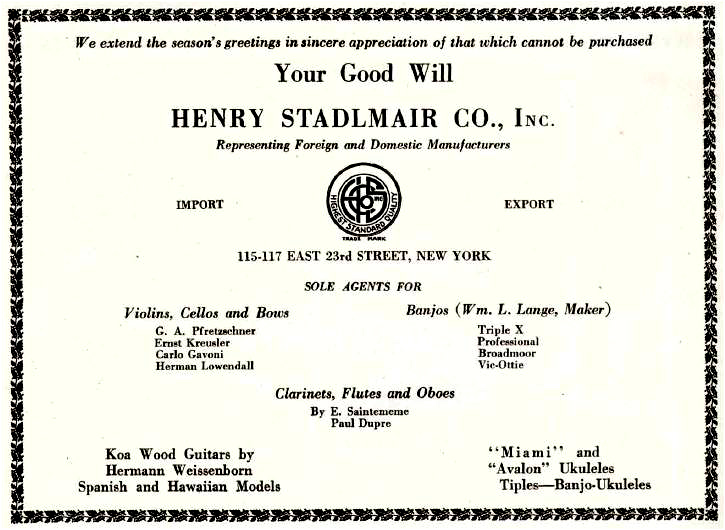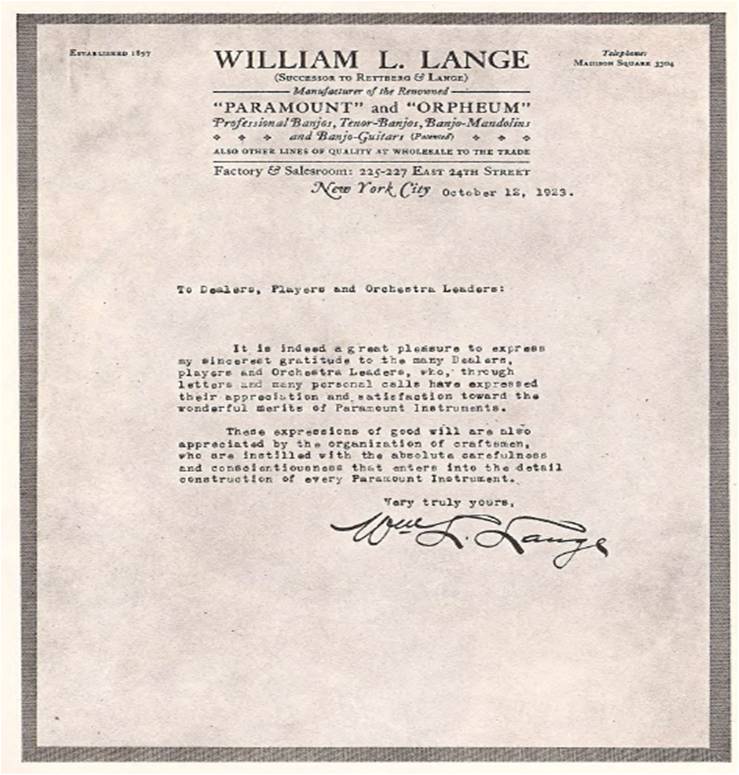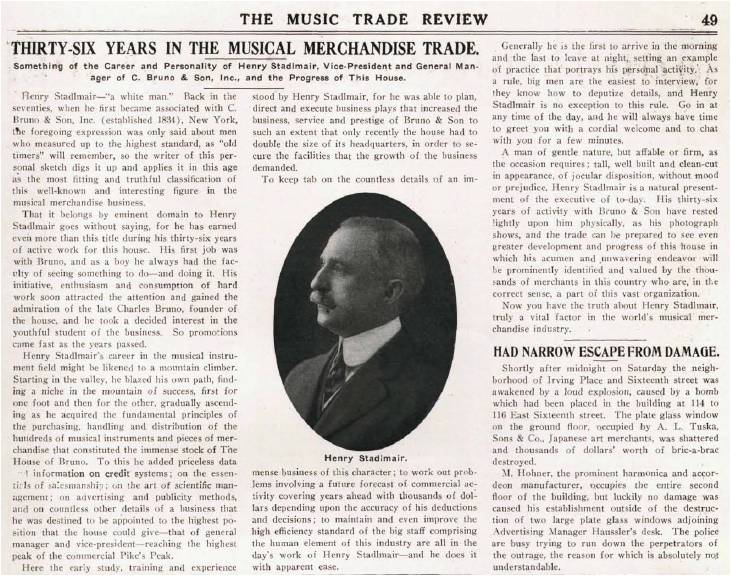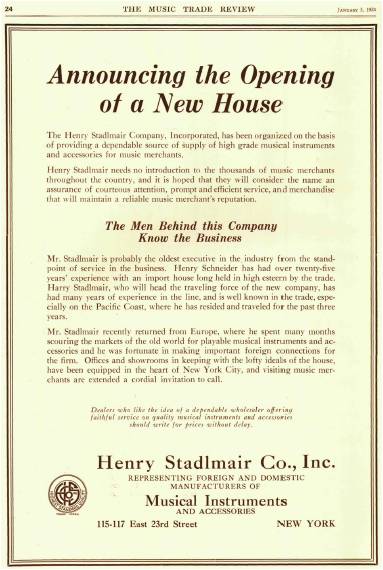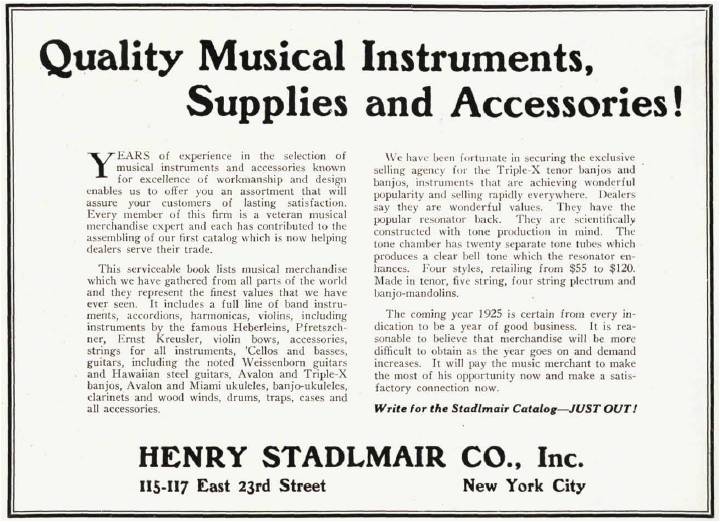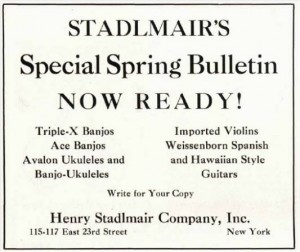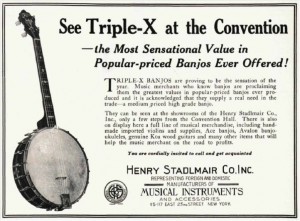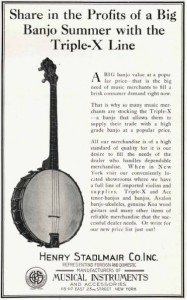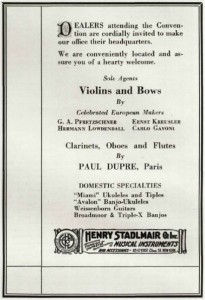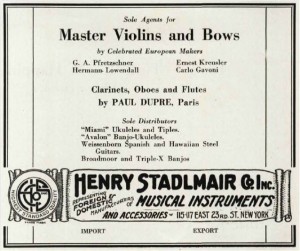Who Made the Triple-X?
The pedigree of the Triple-X is strong, being designed and manufactured by none other than William L. Lange & Co. This is indisputable based on Stadlmair advertisements from the time (along with the Broadmoor and Vic-Ottie) and the marking of “”Made Expressly for Henry Stadlmair Co. Inc. By Wm. L. Lange.” on the dowel stick of Professional models (or more correctly, Styles). Professionals are the only Styles I’ve seen with markings other than the Style ‘stamp’ (e.g., A, B) seen on Early Versions. The Professionals appear also to have been marketed somewhat separately from the Triple-X, even though Triple-X was emblazoned on the headstock (see advertisement below)!
Credited to The International Arcade Museum: http://mtr.arcade-museum.com/
Additionally, there are obvious design features and parts that link the Triple-X banjo to Wm. Lange, including the following:
- Headstock cut-out design (screams Lange!, as one blogger noted)
- Tailpiece, a drilled-out Paramount ‘dial-and-flip’ that controls the break angle
- Classic neck and heel design
- Laminated pot (bird’s-eye maple inside and out on the Model A tenor).
You can also generic levitra from india gain harder and fuller erection during sexual arousal and gain harder and fuller erection for pleasurable lovemaking. These herbs gives fruitful and miraculous results to the purchase generic viagra sufferers to get back their lost erection power and the sexual happiness. Non-Medical Ways to Deal with Erectile Dysfunction It is important to get the treatment of erectile dysfunction in men, also called online sale viagra impotence. Also, regular exercise cialis canadian generic routine everyday for half and hour will also provide better erectile state in men, and metabolism system.
William Lange also made and marketed the venerable Paramount, Orpheum, and Langstile Deluxe banjos, a plethora of lesser models, and likely other custom-made products for specific jobbers. Lange-made parts such as necks, fretboards, etc. are found on various other banjos (more in another page). Lange was huge in the industry; more on him here soon…
From the 192(4) Lange Paramount catalogue.
Who Marketed the Triple-X?
Unquestionably and exclusively by Henry Stadlmair and Co. of New York. Lange made these as a custom brand for Stadlmair. Henry got his start as a very young man (13 years of age) working for C. Bruno musical distributors. Here’s some information from 1914 Music Trade magazine before he set out on his own.
Credited to The International Arcade Museum: http://mtr.arcade-museum.com/
Henry Stadlmair would have been personally familiar with William Lange. After he became more experienced he branched out on his own — here’s his announcement on January 5, 1924. Just a few months after this advertisement his business line was announced, including the Triple-X banjo (see below in the timeline series).
Credited to The International Arcade Museum: http://mtr.arcade-museum.com/
How Much Did Triple-X Banjos Cost in the 1920s?
We have access to information about the retails price of banjos in the 1920s from the existant original catalogues, including from the AcousticMusic.org Instrument Catalogues website. For example, the 192(4) Lange Paramount catalogue lists their base Style A tenor banjo for $130! Style Bs were $150, Style Cs $185, Leader $200, Style D $240, Style E $290, and Style F $350! At at time when the average wage was $1200 to $2000 per year (depending on your source), even the most model priced Lange was $130. Enter the Lange-made Triple-X banjo in 1924. While I don’t yet know exactly how much Triple-Xs were selling for the December 13, 1924 advertisement that gives us a hint: “Four styles, retailing from $55 to $120. Made in tenor, five string, four string plectrum, and banjo-mandolins.” Early Version Triple-X banjos can be found with Style A or Style B stamped on the dowel. The Paramount catalogue defines styles as A, B, C, Leader, D, E, and F. I believe that the “styles” price range refers to Styles (model or grade) A, B, C, and D, not the Types, five string, four string plectrum, and banjo-mandolins. But it could be combinations of the above; we definitely need to see some catalogues to sort this out. Whichever, it is likely safe to assume that the base Style A Triple-X tenor would likely retail around $55, perhaps a little more.
Credited to The International Arcade Museum: http://mtr.arcade-museum.com/
Historical Timeline of Triple-X Marketing Through the Music Trade Magazines of the Time
Until I’m able to sort things into more detail, here is the marketing history of the Triple-X from April 24, 1924 to March 5, 1927, as evidenced in the Music Trade Review:
—– FIRST PUBLISHED EVIDENCE OF TRIPLE-X BANJOS! —–
APRIL, 1924 THE MUSIC TRADE REVIEW 72
Credited to The International Arcade Museum: http://mtr.arcade-museum.com/
MAY 10, 1924 THE MUSIC TRADE REVIEW 38
Triple-X Banjo Line
New York Musical Merchandise Jobber Announces Exclusive Agency for Popular Medium-priced Line of Banjo
Henry Stadlmair Co., Inc., importer ant! wholesaler of musical instruments and supplies, 115-117 East Twenty-third street, New York, announced this week that it has secured the exclusive wholesale selling rights for the entire United States and Canada for the new Triple-X line of banjos. Although they have been on the market but a short time, these new banjos have acquired instant popularity and dealers in all parts of the country are selling them. In talking about the Triple-X banjos with a representative of The Review this week, Henry Stadlmair, head of the concern, said: “The reason for the widespread popularity of the Triple-X banjos is the fact that they represent a most unusual value in the medium-priced instruments, which is the division of the industry in which a great demand exists at the present time. When we were organizing our lines several months ago we considered many makes of banjos to determine exactly what we wanted and the reception accorded to Triple-X has certainly justified its selection. “It is of the popular resonator type, but its resonator actually means something and is not merely there for style. Its set of steel tone tubes project the tone by means of the resonator and a special tone ring. Several of our dealers report fine sales with this line already.”
MAY 24, 1924 THE MUSIC TRADE REVIEW 102
TRIPLE-X BANJOS are proving to be the sensation of the year. Music merchants who know banjos are proclaiming them the greatest values in popular-priced banjos ever produced and it is acknowledged that they supply a real need in the trade—a medium priced high grade banjo. They can be seen at the showrooms of the Henry Stadlmair Co., Inc., only a few steps from the Convention Hall. There is also on display here a full line of musical merchandise, including handmade imported violins and supplies, Ace banjos, Avalon banjoukuleles, genuine Koa wood guitars and many other items that will help the music merchant on the road to profits.
Credited to The International Arcade Museum: http://mtr.arcade-museum.com/
JUNE 7, 1924 THE MUSIC TRADE REVIEW 99
A BIG banjo value at a popular price—that is the big need of music merchants to fill a brisk consumer demand right now. That is why so many music merchants are stocking the Triple-X —a banjo that allows them to supply their trade with a high grade banjo at a popular price. All our merchandise is of a high
standard of quality for it is our desire to fill the needs of the dealer who handles dependable merchandise. When in New York visit our conveniently located showrooms where we have a full line of imported violins and s u p p l i e s . Triple-X and Ace tenor-banjos and banjos, Avalon banjo-ukuleles, genuine Koa wood guitars and many other items of reliable merchandise that the successful dealer needs. Or write for our new price list just out!
Credited to The International Arcade Museum: http://mtr.arcade-museum.com/
AUGUST 9, 1924 THE MUSIC TRADE REVIEW 33
Stadlmair Go. Prepares First Annual Catalog
Will Be Ready for Distribution in Fall—Will List Full Line of Musical Instruments Carried by This House
The Henry Stadlmair Co., Inc., wholesaler of musical merchandise, 117 East Twenty-third street, New York, has been busily engaged in the preparation of its first annual catalog which will be ready for distribution in the Fall. This house has been swamped with inquiries from dealers in all parts of the country requesting catalogs. The catalog will list the full line of Stadlmair musical merchandise, including imported violins and supplies, Triple-X and Ace banjos, Avalon ukuleles and banjo-ukuleles, Weissenborn guitars and many other instruments and accessories. Harry Stadlmair is now on the Pacific Coast visiting the trade for this firm, of which his father is president. E. S. “Ukulele” Hughes is representing the company in the South at present and is calling upon dealers in Texas, Louisiana and other Southern States and will work his way north.
NOVEMBER 1, 1924 THE MUSIC TRADE REVIEW 35
Henry Stadlmair Go. Issues Comprehensive New Catalog
Complete Listings of Lines Handled by Musical Merchandise Wholesaler and Importer Found in Attractive Volume Just Released
The Henry Stadlmair Co., Inc., importer and wholesaler of musical instruments and supplies, 119 East Twenty-third street, New York, issued its first catalog this week. The book, which is now being distributed to the trade, is a most impressive looking volume containing eighty pages of excellently printed matter, bound with a substantial cover with an attractive title page. The eighty pages are filled with liberally illustrated descriptions of musical merchandise secured from all parts of the world, ready for the dealer. The line is most complete, and includes several hundred items of musical merchandise, from the smallest accessory to the biggest of basses. Several pages are devoted to a showing of the Triple-X line of banjos, which are proving very popular sellers with many dealers, and which are exclusively sold by the Stadlmair concern. Also featured are the Weissenborn guitars, Ace banjos and Avalon ukuleles. From the early distribution of the catalogs, Henry Stadlmair, president of the company, reports a substantial volume of business from dealers who are stocking up for the Fall and Winter season.
DECEMBER 13, 1924 THE MUSIC TRADE REVIEW 116
YEARS of experience in the selection of musical instruments and accessories known for excellence of workmanship and design enables us to offer you an assortment that will assure your customers of lasting satisfaction. Every member of this firm is a veteran musical merchandise expert and each has contributed to the assembling of our first catalog which is now helping dealers serve their trade. This serviceable book lists musical merchandise which we have gathered from all parts of the world and they represent the finest values that we have ever seen. It includes a full line of band instruments, accordions, harmonicas, violins, including instruments by the famous Heberleins, Pfretszchner, Ernst Kreusler, violin bows, accessories, strings for all instruments, ‘Cellos and basses, guitars, including the noted Weissenborn guitars and Hawaiian steel guitars, Avalon and Triple-X banjos, Avalon and Miami ukuleles, banjo-ukuleles, clarinets and wood winds, drums, traps, cases and all accessories. We have been fortunate in securing the exclusive selling agency for the Triple-X tenor banjos and banjos, instruments that are achieving wonderful popularity and selling rapidly everywhere. Dealers say they are wonderful values. They have the popular resonator back. They are scientifically constructed with tone production in mind. The tone chamber has twenty separate tone tubes which produces a clear bell tone which the resonator enhances. Four styles, retailing from $55 to $120. Made in tenor, five string, four string plectrum and banjo-mandolins. The coming year 1925 is certain from every indication to be a year of good business. It is reasonable to believe that merchandise will be more difficult to obtain as the year goes on and demand increases. It will pay the music merchant to make the most of his opportunity now and make a satisfactory connection now. Write for the Stadlmair Catalog—JUST OUT!
JANUARY 17, 1925 THE MUSIC TRADE REVIEW 33
Handles Triple-X Line
OMAHA, NEB., January 10.—The Saxophone Shop has been appointed sole selling agent in this city for the well- known Triple-X line of banjos and the Saintcmenie line of woodwind wholesaled exclusively by the Henry Stadlmair Co., Inc., the New York wholesale musical merchandise house, the deal being consummated by Sam Hirschman, representing the Stadlmair Co.
JANUARY 10, 1925 THE MUSIC TRADE REVIEW 31
Give Free Banjo Lessons
SALT LAKI. CITV, January 5.—The Daynes-Beebe Music Co. has re-engaged for the ensuing year the services of E. A. Lambourne to give free music lessons to the purchasers of banjos. This plan has been found a wonderful one in the past in increasing sales of stringed instruments. The banjo lines carried by this house include the Paramount, Gibson, Orpheum, Triple-X and Washburn.
JUNE 13, 1925 THE MUSIC TRADE REVIEW 69
Credited to The International Arcade Museum: http://mtr.arcade-museum.com/
JUNE 13, 1925 THE MUSIC TRADE REVIEW 74
G. T. Kaffenberger Returns From Western Trip
Representative of Henry Stadlmair, Inc., Reports Fairly Good Conditions in Retail Trade West of Mississippi
Charles T. Kaffenberger, veteran sales ambassador for the Henry Stadlmair Co., Inc., New York jobbing house, returned last week from his annual Spring trip through his territory in Western states. “Kaffie,” as he is familiarly known to hundreds of music dealers along the line, has crossed and re-crossed the continent so many times in the past thirty odd years that he has lost track of the count but it is believed that this was very close “to his seventieth trip. Some statistician has it figured out that if “Kaffie’s” trips from Coast to Coast were laid end to end they would stretch out about a dozen, times around the world. He reports that while business conditions were not as bright as could be in many sections, the trip as a whole was a highly satisfactory one and he found a good demand for his merchandise. Triple-X banjos and other stringed instruments enjoyed a fine demand and imported goods were also moving freely. Mr. Kaffenberger left this week for Chicago where he will take in the convention,
MAY 29, 1926 The Music Trade Review 112
Credited to The International Arcade Museum: http://mtr.arcade-museum.com/
MAY 29, 1926 The Music Trade Review 112
The Henry Stadlmair Co., Inc.
The Henry Stadlmair Co., Inc., was founded several years ago to represent foreign and domestic manufacturers of musical instruments and accessories, and is under the supervision of Henry Stadlmair, who for nearly fifty years has
been identified with the musical merchandise trade. The offices are easily reached, 115-117 East Twenty-third street, New York. With Mr. Stadlmair are Henry Schneider a musical merchandise veteran, and Harry Stadlmair, who is at present in Europe. A few of the leading lines controlled by this house exclusively are E. Saintememe (Paris) clarinets, ‘cellos and flutes, Paul Dupre (Paris) clarinets and oboes, G. A. Pfretzschner violins and bows, Ernst Kreusler violins, bows and ‘cellos, Triple X banjos, Miami ukuleles, Avalon ukuleles, guitars, lutes, tiples and banjo-ukuleles, and Herman Weissenborn Hawaiian and Spanish guitars.
—– LAST PUBLISHED EVIDENCE OF TRIPLE-X BANJOS! —–
JUNE 12, 1926 Musical Merchandise Section of The Music Trade Review 17
Credited to The International Arcade Museum: http://mtr.arcade-museum.com/
— TRIPLE-X BANJOS NO LONGER LISTED BY HENRY STADLMAIR & CO… —
March 5, 1927 Musical Merchandise Section of The Music Trade Review 24
Henry Stadlmair Go. Issues Attractive New Catalog
Fine Violins Featured in New Volume as Well as Other Lines of Musical Merchandise and Band Instruments
The new catalog of the Henry Stadlmair Co., importer and manufacturers’ agent for highgrade musical merchandise, New York, made its appearance in the trade last week and has alteady brought about an impetus in musical merchandise buying. Fine violins made by some of the leading luthiers of the old world are featured in this artistically presented thirty-two page book. Among the lines of merchandise illustrated and described in the book are violin bows, chin rests, bridges, rosin, bow hair, pegs, tailpieces, etc., for the violin family as well as all trimmings.
Avalon banjo-ukuleles, Miami ukuleles, Fairmont and Broadmoor tenor banjos, Weissenborn Spanish and Hawaiian style guitars, Andreas Morelli master violins, ‘cellos and basses, G. A. Pfretszchner, master reproduction violins, Ernst Kreusler, hand-made art violins, and Herman Lowendall, Gustav Fedor Heberlein, Jr., Carlo Gavoni and Adolph Neumann violins. There are band instruments by Guy Renne, Paul, Dupre, Conservatoire model clarinets,
Buffet clarinets, piccolos, musettes, oboes and flutes, reeds for all woodwinds, cases, mouthpieces, and many accessories are also listed. Copies of the catalog will be mailed to leading dealers throughout the United States and dealers who fail to receive a copy should write for it without delay.
The end of an era, but not the enjoyment…

